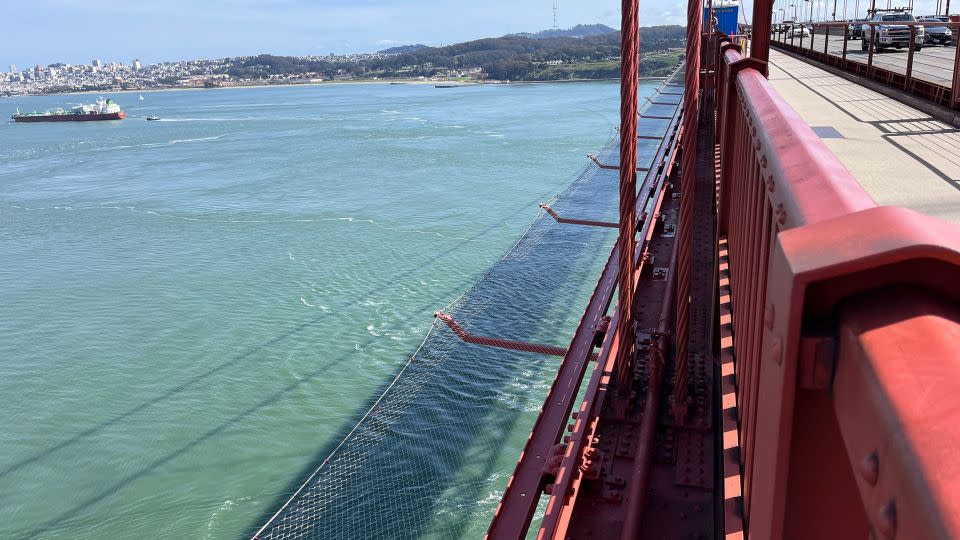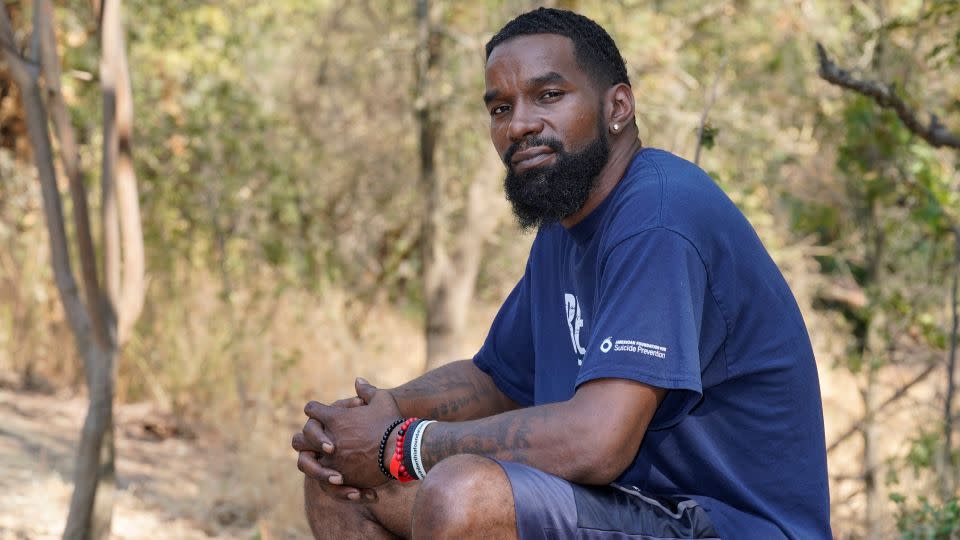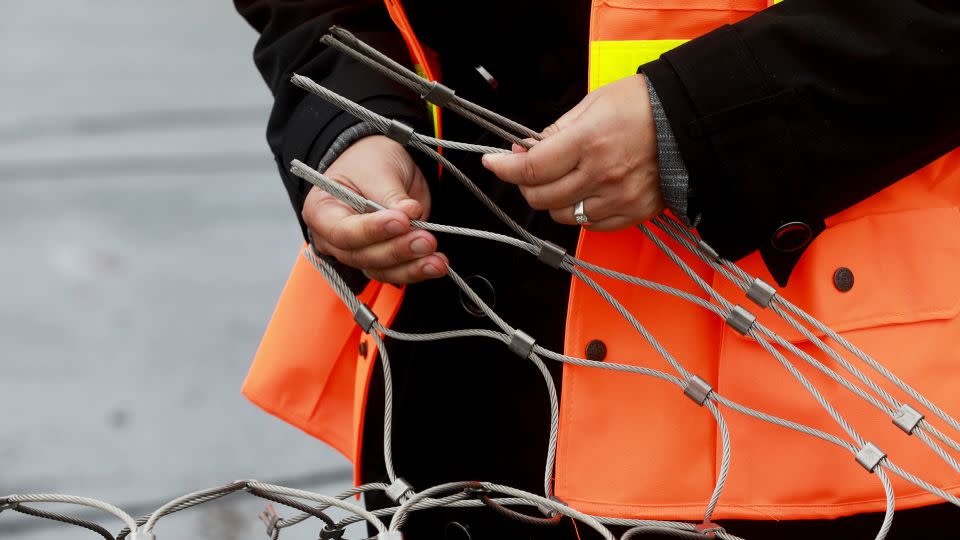‘All I wanted to do was live’: After years of debate, a suicide safety net for the Golden Gate Bridge is nearing completion. Survivors say it’ll give many a 2nd chance at life
On September 25, 2000, Kevin Hines climbed over the rail of the Golden Gate Bridge.
White fog hung below the gray skies that day. He recalled looking down at the rough, green waters below moments before he did the unthinkable: He jumped.
“My hands left the rail and I had an instantaneous regret for my actions,” Hines told CNN.
Hines fell 220 feet at a speed of 75 miles per hour – “equivalent to a pedestrian being struck by a car that is traveling that fast,” according to the Bridge Rail Foundation, a nonprofit working to prevent suicides on the bridge.
During the 4-second fall, Hines said the feeling of depression left his mind, and was replaced by a survival urge he described as almost instinctual.
“And at that time, all I wanted to do was live.”
After he was rescued from the water, Hines needed three vertebrae replaced with a titanium metal plate and pins, ultimately undergoing four and half weeks of recovery. And in the years since, Hines has been traveling the world to share his rare testimony.
“I have met thousands of people who have survived mild, moderate to extreme suicide attempts who have all said they each had the same instant regret,” Hines said. “They recognized their thoughts didn’t have to become their actions.”
More than a confirmed 1,800 people have jumped from the Golden Gate Bridge since it was built in 1937, according to the Bridge Rail Foundation. The very first incident happened that same year.
Hines is one of 39 people known to survive the deadly leap. “Nineteen have come forward to say they all had the exact same instant regret that I had,” Hines said.

After years of debate over installing a suicide deterrent on the iconic bridge, a net is now nearing completion.
In 2018, the Golden Gate Bridge, Highway and Transportation District began building a net along the perimeter of the 1.7 mile long bridge.
The $217 million project consists of the installation of a stainless steel net, 20 feet below the sidewalk on both sides of the bridge, according to Golden Gate Bridge spokesperson Paolo Cosulich-Schwartz.
“The amount of net that we’re installing is the equivalent of seven football fields,” Cosulich-Schwartz told CNN.
It’s a project proponents hope will offer many people a second chance at life.
While Hines noted not all those who jump may feel regretful, he said he can’t help but empathize with those who did experience the same feeling but never got another chance to choose life.
“Recognizing that all the people that passed away might have wished they were still here… it’s a very troubling thing to think about,” he said.
‘A symbol of hope and care’
Kevin Berthia attempted to jump off the Golden Gate on March 11, 2005. But after jumping, he ended up clinging to a railing for over an hour and a half.
“I swung myself around and smacked into the railing, and got on that 4-inch cord,” Berthia recalled.

And he held onto that cord as California Highway Patrol Officer Kevin Briggs talked to him about reasons to choose life. It was in this 92-minute conversation that Berthia began to experience regret.
While he credits Briggs for saving his life, Berthia also said he believes a safety net would have made a world of difference that day.
“I looked over that rail and all I saw was the water,” Berthia told CNN. “If I saw a deterrent, I would have probably been like, ‘OK, maybe this is not meant to be.’”
He desperately needed a sign that someone cared about him, Berthia added: “I needed something to say no.”
While the purpose of the net is “to reduce the number of injuries and deaths from jumping off the bridge,” bridge spokesperson Cosulich-Schwartz said it’s also meant to serve as that sign Berthia was looking for 18 years ago.
“The net is a symbol of hope and care for people who may be experiencing the worst day of their lives,” Cosulich-Schwartz said.
“It is a large, visible and permanent symbol that there are people in the community that care about you,” he continued. “And, if necessary, offer people a second chance.”
The net is currently 80% built, and is set to be completed in December, according to the bridge officials.
The construction of this deterrent won’t be a temporary solution in suicide prevention, according to researchers.
A 1978 study of Golden Gate Bridge suicide attempters found more than 90% of those who were stopped remained alive decades later, and didn’t go on to take their own lives.

The fight for the net
Since the Golden Gate’s opening, suicide prevention groups and nonprofits like the Bridge Rail Foundation have continuously pushed for a deterrent of some sort on the bridge.
“Originally, we wanted to raise the rail,” Hines said, which would be similar to the 11-foot steel fence that encloses the George Washington Bridge in New York City.
The transportation district invited public comment on the potential project, and the opinions of the board and local residents were deeply divided.
“We got shut down with that because it was obstructing the view and people didn’t want to ruin the aesthetics of the bridge,” Hines told CNN. “And I always say, what are the aesthetics of a bridge compared to one human life?”
In 2014, the bridge’s board of directors unanimously approved the funding for the safety net construction.
“Engineers designed the Net to minimize impacts to Bridge views and appearance,” according to a Golden Gate Bridge, Highway and Transportation District release, which noted the addition would still “slightly diminish the integrity of the the historic features.”
Berthia acknowledged many people enjoy the beauty and history of the Golden Gate. “And I get that, but we don’t listen to enough people that have lost loved ones off that bridge,” he said.
Thirty people or more die by suicide at the bridge each year on average, according to the release, with hundreds more stopped by law enforcement or other citizens.
“Ultimately, a physical barrier is needed to stop this tragedy,” the release said. “The selected design allows open, scenic vistas to remain intact, while preventing anyone from easily jumping to the water below.”
“I’m so grateful that not one more beautiful person with loved ones, and family and friends who care for them is ever again, gonna die by their hands off of the Golden Gate Bridge,” Hines said. “I thank God every day I get to be alive to see it.”
If you’re experiencing any thoughts of suicide or any form of self-harm, please call the National Suicide Prevention Lifeline at 988. It provides free and confidential support 24 hours a day, seven days a week. You can also call that number to talk to someone about how you can help a person in crisis. For crisis support in Spanish, call 1-888-628-9454. You can also text CNQR to 741741 for free and confidential crisis support.
For more CNN news and newsletters create an account at CNN.com

